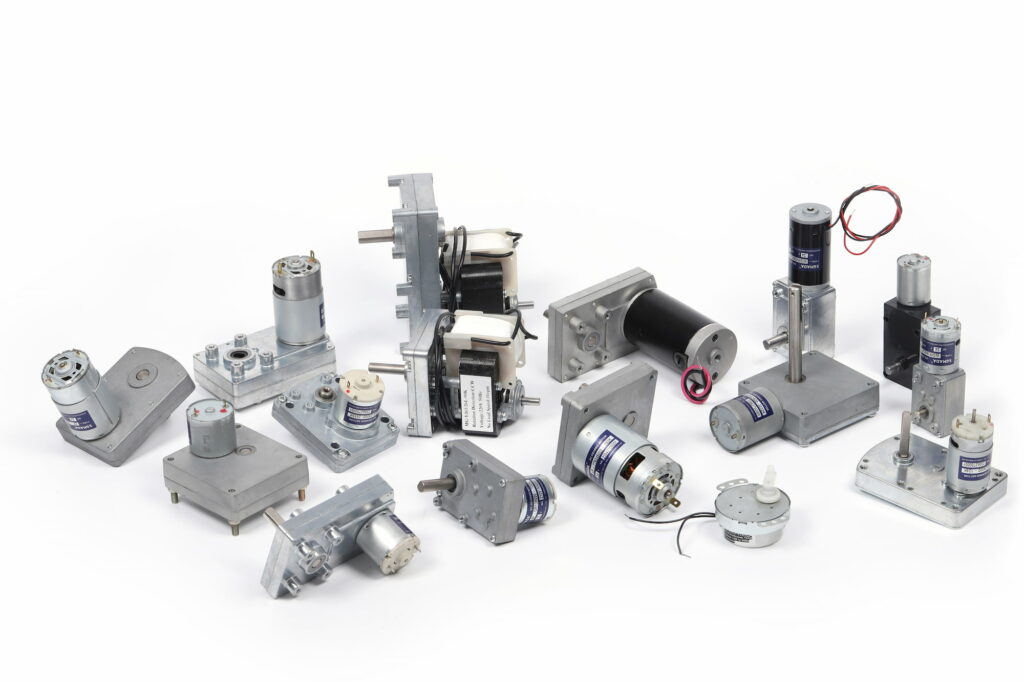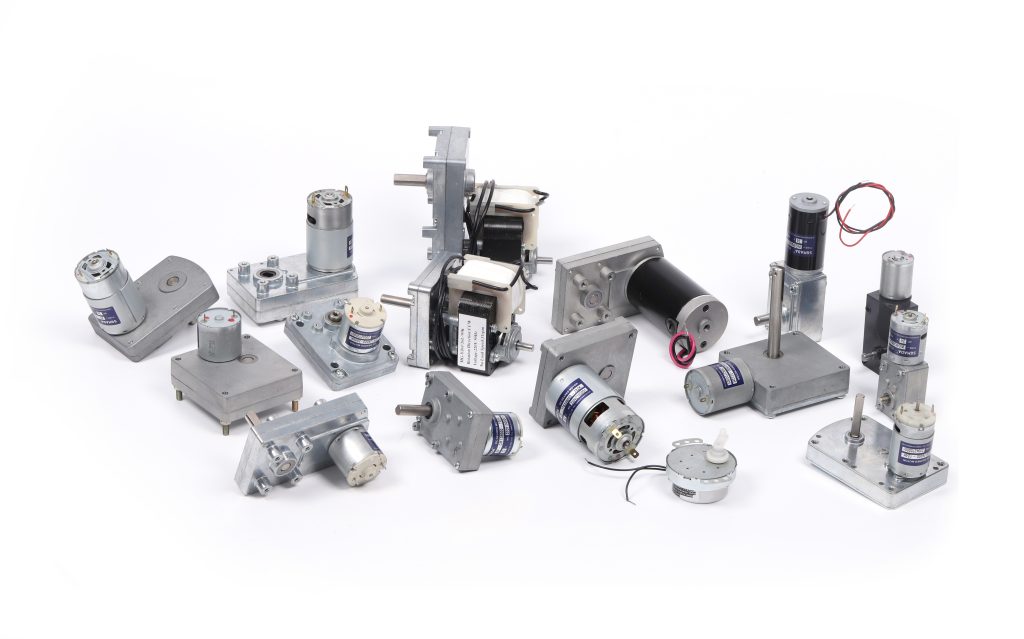A gearbox motor, also known as a gear motor, is a high-torque low-speed motor that combines a gearbox with an electric motor. The combination of motor and gearbox can provide customers with thousands of ratios of motor output torque and speed. Therefore, gearbox motors are mainly used in high-torque, low-speed precision transmission fields such as robots, automation, medical equipment, industrial equipment, agricultural equipment and other fields.
Types of Gearbox Motor
A gearbox motor is a special type of electric motor that produces high torque while maintaining low horsepower (or low speed). The function of the gearbox is to increase the output torque of the gearbox motor by reducing the speed of the output shaft end of the motor. A gearbox can be thought of as a reduction mechanism. Compared with the direct production of low-speed motors, the production cost of gearboxes is lower, and the design difficulty is simple. Therefore, the gearbox motor is an indispensable part in the field of micro transmission.
Gearbox motors come in a variety of types, each with their unique advantages, reduction structure, and applications. These include, but are not limited to:
A perfect example of the application of gearbox motors can be seen in power tools and industrial machinery where high torque is essential for effective performance. These motors also find usage in robotics, automobile transmissions, and even in medical equipment.
Note: The choice of gearbox type is entirely dependent on the specific needs of the application. For the selection of gearbox motors, there is no fixed solution, only the most suitable one. DONCEN MOTOR focuses on the development and manufacture of gearbox motors. For 20 years, we have provided customers with the most cost-effective gearbox motors. DONCEN provides customers with valuable and competitive products according to their requirements.

What’s Inside a Gearbox?
The gearbox is an integral mechanical structure based on the gear transmission system. Gearboxes include but are not limited to: gears, shaft, lubricating oil, needle shafts, spacers, bearings and gearbox housings. DONCEN MOTOR will focus on the needs of customers and provide you with gearbox accessories of different materials to provide customers with the most cost-effective gearbox motor.
Gearbox Gears
The gears in the micro gearbox are mainly low-modulus, high-precision gears. DONCEN MOTOR provides plastic gears, powder metallurgy gears, and hobbed gears. Our engineer team will select the most suitable gear material for customers according to their needs and application environment.



| Gear Type | Advantages | Disadvantages |
|---|---|---|
| Plastic Gears | Cheap, Corrosion resistant, Low noise, Self-lubricating | Heat sensitivity, Higher wear, Low load capacity |
| Powder Metallurgy Gears | High production rates, Material efficiency, Versatility | Porosity, Less dimensional accuracy, mediujm load capacity |
| Hobbed Gears | High accuracy, Flexibility, Higher load cpaacity | Expansive, Regular maintenance required |
DONCEN MOTOR focuses on the research and design of micro gearbox gears. We will be committed to providing the best gears to our customers.
Gearbox Shaft
Gearbox shaft is a critical component of the gearbox motor as it connects the motor to the application or device it is powering, enabling the transmission of mechanical energy.
The following are several common gearbox output shafts



In the gearbox motor, the output shaft is responsible for outputting torque, bearing load, and connecting application equipment. Therefore, the output shaft is the key connection accessory in the gearbox.
Gearbox Bearing
Bearings are critical components in a gearbox motor. Bearings have the following main functions
- Reduce friction: The main function of bearings is to reduce friction between gearbox components. In a gearbox, bearings are placed between the rotating shaft and the stationary gearbox housing for smooth rotation.
- Load Support: Bearings support the load transmitted through the drive gear. They need to withstand radial loads (perpendicular to the shaft) and axial loads (along the length of the shaft) from gear forces.
- Rotation: Bearings allow the shaft to rotate freely within the gearbox, helping power to be transmitted smoothly through the gears from the input shaft to the output shaft.
- Alignment: By maintaining proper shaft alignment, bearings ensure efficient power transmission and help avoid excessive gear wear or damage. Misalignment can lead to premature transmission wear, inefficient operation and potential failure.
- Heat Dissipation: Bearings also help dissipate heat away from the gearbox, helping to maintain optimal operating temperatures and extend overall system life.
- Reduced Vibration: By providing smooth rotation, bearings help reduce vibration within the gearbox, resulting in quieter, more efficient operation.

Lubrication
The lubrication system used inside the gearbox is mainly lubricating oil, which can reduce the friction in the gear transmission system. Effectively protect the life of the gears and reduce the noise emitted by the gear box during transmission.
Gearbox Casing
The gearbox housing is the housing used to house all the accessories of the gearbox. The main function of the casing is to provide mechanical support for the components that are driven in it, and to provide protection for these internal components from external interference.
Aluminum Alloy:
Advantages:
- Lightweight: Aluminum alloys are lighter than many other metals, which can contribute to reducing the total weight of a system.
- Corrosion Resistance: Aluminum forms a protective oxide layer naturally, which helps it resist corrosion, especially important in harsh environments.
- Heat Dissipation: Aluminum alloys are excellent conductors of heat, which is beneficial for components that generate a lot of heat like motors and gearboxes.
- Strength: Despite being lightweight, aluminum alloys are strong and can withstand substantial loads.
Disadvantages:
- Cost: Aluminum alloys are typically more expensive than other common materials used for gearboxes.
- Wear: Without proper surface treatments, aluminum can wear quickly under high-load or high-speed conditions.
Zinc Alloy:
Advantages:
- Strength: Zinc alloys are very strong and tough, which makes them ideal for heavy-duty applications.
- Precision: Zinc alloys can be cast with very high precision, which is beneficial for complex gearbox designs.
Disadvantages:
- Weight: Zinc alloys are heavier than aluminum and plastics, which might not be ideal for applications where weight is a concern.
- Corrosion: Zinc alloys can corrode over time if not properly treated or maintained.
ABS (Acrylonitrile Butadiene Styrene) Plastic:
Advantages:
- Cost-effective: ABS is typically cheaper than metal counterparts, making it a cost-effective choice for housing.
- Lightweight: ABS is lighter than metals, which can be advantageous in certain applications.
- Flexibility: ABS can be molded into complex shapes and sizes, allowing for more design flexibility.
Disadvantages:
- Heat Resistance: ABS may not handle heat as well as metal options. High temperatures can lead to deformation or even melting.
- Strength: While ABS is reasonably strong for a plastic, it’s not as strong or durable as metal options, especially under high load or stress conditions.
Each material has its strengths and weaknesses, and the choice depends on the specific requirements of the application, including the working environment, load conditions, design complexity, and budget considerations.
Matching a Gearbox with a Motor
Selecting a suitable motor to pair with your gearbox is as crucial as selecting the gearbox itself. A mismatched gearbox-motor combination can lead to inefficiency, poor performance, and even premature failure of the system. Here’s a step-by-step guide on how you can accurately match a gearbox and motor:
- Define Your Requirements: Firstly, you should have a clear understanding of the power, speed, and torque requirements of your application. Other factors to consider include the operating environment and duty cycle.
- Select a Suitable Motor: Once you’ve established your requirements, it’s time to choose types of motor that can meet these needs. DC brush motor is a cheap and high effiency chocie. BLDC motor more suitable for precise control and long-term working areas. Stepper Motor suitable for high-precision control fields.
- Choose the Right Gearbox: Now, pick a gearbox that complements your chosen motor. There are many types of gearboxes. Cheap and stable spur gearbox. Planetary gear with reasonable transmission structure. Radial output worm gear, high-precision harmonics, etc.
- Calculate Gear Ratios: Gear ratios play a crucial role in determining how well your gearbox will translate the motor’s input to the desired output. An excellent resource for understanding gear ratios can be found in this article.
- Test and Validate: After matching a motor with a gearbox, it’s important to test the system to ensure it meets the required specifications. Adjustments may be necessary for optimal performance.
Remember: When it comes to pairing a motor with a gearbox, the objective is to create a system that can deliver the desired output efficiently and reliably under the conditions of the specific application.
In conclusion, understanding the gearbox motor, its components, its types, and how to match it with a motor is integral to leveraging its capabilities. At Doncen Motor, we excel in providing a wide range of high-quality gearboxes and motors that can meet various applications. Be it the Planetary Gear Motor, the Spur Gearbox, or the DC Geared Motor, we have it all. Explore our catalog to find the perfect motor and gearbox for your needs today!
Author’s Note: This article has been written with the engineer’s perspective in mind, considering the logic and precision that drives our field. It aims to provide a comprehensive guide to gearbox motors for both seasoned engineers and novices in the field. As always, if you have any queries or need further assistance, feel free to contact us.
Thanks for the SGMADA provide the technical support for this article!






